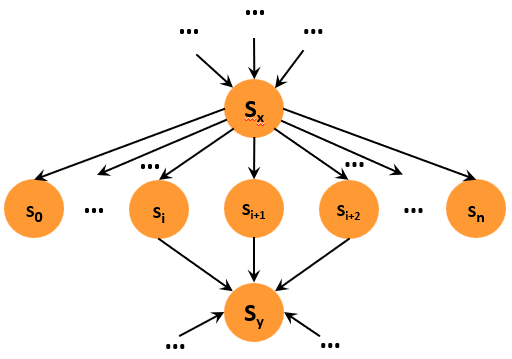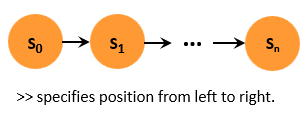Path Operator Examples
Many constraints on a path can be expressed using Cyclone's path operators. Understanding Cyclone's path operators is the key to express the kinds of constraints you want to capture. In this Section, we show a few examples of some of the path operators and their semantics.
Definition:
Given a path condition c, Cyclone discovers a path p that provably satisfies c.
Example 1.
condition ( S1->S2->S3 )
The path condition in Example 1 means that S1->S2->S3 is a subpath that can appear anywhere in a path to be discovered (by Cyclone). In other words, a path p must include S1->S2->S3.
Example 2.
condition ( S1 && !S2 )
This path condition specifies a compound path condition that contains two path conditions: S1 and !S2. Hence, this condition means that p must include node S1 and exclude S2. Note that operator ! denotes exclusion, though it looks the same as logical not operator.
Example 3.
condition ( Sx->_->Sy )
This condition uses an any one operator(_) to indicate a subpath that from Sx must go through one node to Sy. But we don't know which one. This depends on the node picked by Cyclone and the connections between Sx and Sy. Given the following part of a graph, any one operator means it could be any one of these nodes: S0,...,Si,Si+1,Si+2,...Sn.

Hence, the above condition is equivalent to the following:
condition ( Sx->S0->Sy || Sx->Si->Sy || ... ||Sx->Sn->Sy )
Example 4.
condition ( (S1->S2->S3)^{1:3} )
The above path condition specifies S1->S2->S3 must occur between 1 and 3 times (inclusive) in p. Path operator ^{i:j} (postfix operator) can be applied to a node and a path. However, this operator requires parentheses for a path. For example, the following condition:
condition ( S1^{2}, S1->S2->S3^{1:3} )
Ths first condition specifies node S1 must occur exactly twice in p. The second condition is illegal. The current version of Cyclone cannot recognize such usage.
Example 5.
condition ( >>(S1->S2->S3) && <<(S1->S2->S3) )
The condition above uses both place operator (prefix): >> and <<. Place operator allows users to specify an exact location that a node or a path can appear in p. Operator >> calculates location from left to right, and << does it from right to left. The exact location in p is specified using an index value starting from 0 to n where n is the length of p (|p|). In the case when there is no index value specified, the default value 0 is used. The following diagrams illustrate >> and <<.


The index value(s) are specified using subscripts. S1 has an index value of 1. For a node, the valid index ranges from 0 to n. For a path s, the valid index values depend on the length of s. For example, let |p| = 6 and s be X->Y. The maximum index value can go is 5, since |s| is 2.
Any values beyond that is illegal. The following diagram illustrates this example.

Hence, our path condition requires Cyclone to find a p that starts and ends with the same subpath: S1->S2->S3
Example 6.
condition ( >>2(S1->S2->S3) && (S1->S2->S3)^{3} )
The above compound path condition specifies that S1->S2->S3 must start at third node in p and it must occur (in p) three times. In this case, you can take an advantage of using both prefix and postfix operators and merge them into one single path condition.
condition ( >>2(S1->S2->S3)^{3} )
Exercises
Determine the semantic validity of each of the following path condition. If a condition is valid, explain its meaning in English
1: condition ( S1^{1:2} && (S4->S5) || S5->!S6 )
2: condition ( S1->_->_->S1 || (S1->S1)^{2:4} )
3: condition ( >>3(S3->_->S7)^{2:4} )
4: check for 6 condition ( >>(S1->S2)^{2} || <<2(S5->S6) )
5: check for 6 condition ( >>6(S3->S4) || !(S3->S4)^{2} )
6: check for 7,8,9 condition (>>(_->_->S5), S5^{3})reach(S1,S2,S3)
7: check for 7 condition (<<6(S2->S3),S1^{2:3}^S4^S5,!(!S5))reach(S1,S2)
Execution Result
Press 'run' to execute the code and see checking results.
Execution server didn't supply any information
URL: /server